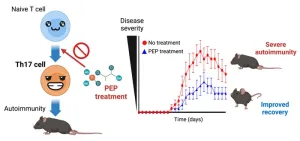(Press-News.org) Research Highlights:
A new study found that the link between excess weight and higher blood pressure in adolescents was stronger among those who also had irregular sleep patterns.
Irregular sleep patterns contributed to elevated blood pressure in teens who had more visceral fat (excess weight in the belly/abdominal area).
The researchers suggest that school schedules and extracurricular responsibilities often clash with teens’ natural tendency to go to bed later and sleep later, which may lead to irregular timing of sleep and a cascade of consequences for heart health later in life.
Embargoed until 4 a.m. CT/5 a.m. ET Monday, March 6, 2023
DALLAS, March 6, 2023 — Staying awake later into the night and sleeping in on the weekends are hallmarks of adolescent behavior, however, erratic sleep patterns may have consequences for future heart health by increasing blood pressure among teens who have more abdominal fat, according to new research published today in Hypertension, an American Heart Association journal.
“Pediatricians should pay close attention to youth who are experiencing weight gain or have already become overweight and examine their sleep patterns, since a more regular sleep schedule may help them with weight loss and improve their long-term heart health,” said Julio Fernandez-Mendoza, Ph.D., senior author of the study, an associate professor at the Penn State College of Medicine and sleep psychologist at the Sleep Research & Treatment Center of Penn State College of Medicine in Hershey, Pennsylvania.
Healthy sleep is a key factor in total cardiovascular health, as defined by the American Heart Association’s Life’s Essential 8, which also includes physical activity, not smoking, healthy weight and healthy levels of cholesterol, blood sugar and blood pressure. According to the Association’s cardiovascular health metrics, teens ages 13-18 should get 8 to 10 hours of sleep each night.
The researchers evaluated sleep, visceral fat and blood pressure in 303 adolescents from central Pennsylvania (average age 16.2 years; 47.5% female; 21.5% Black or Hispanic) who returned for a repeat evaluation after participating as children in the Penn State Child Cohort study. Sleep was measured during one night in the sleep lab, and at home over 7 days by wearing a wristwatch-like sleep monitoring device. With this device researchers tracked sleep duration and its variability (to capture how much and how little adolescents slept night-to-night), and sleep midpoint (the midpoint between sleep and wake-up time) and its regularity (to capture their sleep patterns over time). A sleep midpoint at 2 a.m. or later is considered delayed for a typical adolescent during the school week, and night-to-night differences of 45 minutes or more in the sleep midpoint was considered highly irregular.
Visceral abdominal fat, which is the deep belly fat that surrounds the stomach, liver and intestines, was measured with a dual-energy, X-ray absorptiometry (DEXA) scan during the sleep lab visit. Visceral fat is more dangerous to heart health than fat stored just under the skin. Seated blood pressure was measured also during the sleep lab visit 3 times at 5-minute intervals, with the last 2 readings averaged.
Among the findings:
Overall, the participants had sleep habits typical of adolescents – going to bed later than they did during grade school, and sleeping later on weekends and school breaks than on school days.
Among the adolescents studied during the school year and whose sleep varied by 45 minutes or more during the school week, each unit increase in visceral abdominal fat was linked to a 7 mm Hg higher systolic (top number) blood pressure and a 3 mm Hg higher diastolic (bottom number) blood pressure.
In contrast, among teens whose sleep varied less than 45 minutes during the school week, there was no link between visceral abdominal fat and elevated blood pressure.
For those who fell asleep later on weekdays (with a sleep midpoint of 2 a.m. or later), each unit increase in visceral abdominal fat was linked to a 5 mm Hg increase in systolic blood pressure and a 2 mm Hg increase in diastolic blood pressure. For those who went to sleep earlier, there was no link between visceral abdominal fat and elevated blood pressure.
Among the teens who participated in the study during a school break, neither a delayed sleep midpoint nor sleep regularity significantly altered the link between visceral abdominal fat and blood pressure.
In teens who described themselves as “evening people,” each unit increase in visceral abdominal fat was linked to about a 3 mm Hg higher diastolic blood pressure, however, among self-described “morning people,” there was no impact of visceral abdominal fat on blood pressure.
“These results suggest that keeping a regular sleep pattern may protect adolescents from the cardiovascular consequences of obesity,” said Natasha Morales-Ghinaglia, B.S., first author of the study and an American Heart Association predoctoral fellow at the Penn State College of Medicine Sleep Research & Treatment Center in Hummelstown, Pennsylvania.
Morales-Ghinaglia added, “Teens are not wrong in following their normal inclinations to sleep later than in their childhood years. Rather, it’s a normal developmental pattern that previous studies have shown to be at odds with certain aspects of teen lifestyle ― primarily school and extracurricular activity schedules.”
Sleep experts have stressed that early middle and high school start times often make it difficult for teens to get regular, sufficient sleep. Morales-Ghinaglia encourages parents and teens to understand their body’s needs. “It’s important to educate teens on how important it is to have regular sleep. They don’t need an early bedtime like younger children, but it’s important to get more regular sleep for the benefit of their heart and mental health.”
Fernandez-Mendoza adds that changing middle and high school start times, among other potential interventions, such as educating administrators, teachers, school clinicians, parents and youth on sleep and circadian rhythms, may improve school attendance, academic performance and emotional functioning. “It is time to raise awareness that having a misalignment between sleep patterns and school schedules may mean more obesity, more depression, worse performance and more heart disease among adolescents.”
The study has several limitations. Because it was not a controlled trial, where researchers could compare groups based on factors like sleep conditions or patterns, and the participants were studied at a single time, the results cannot demonstrate a cause-and-effect link between sleep habits and blood pressure. Sleep was evaluated by one night in the sleep lab and 7 nights at home, which may not be as reliable as measurements from more than one night in a sleep lab and 14 nights or more of home monitoring so that more weekend nights are captured. Blood pressure was measured only in the lab, which may be a less accurate reflection of usual blood pressure levels such as those taken during 24-hour monitoring with multiple readings.
Fernandez-Mendoza is currently inviting the teen Penn State Child Cohort participants to return for another evaluation as young adults ages 20 and older.
Co-authors are Michael Larsen, B.S.; Fan He, Ph.D.; Susan L. Calhoun, Ph.D.; Alexandros N. Vgontzas, M.D.; Jason Liao, Ph.D.; Duanping Liao, M.D., Ph.D.; and Edward O. Bixler, Ph.D. Authors’ disclosures are listed in the manuscript.
The study was funded by the National Heart, Lung, and Blood Institute, the National Institute of Mental Health, the National Center for Advancing Translational Sciences, which are divisions of the National Institutes of Health, and the American Heart Association.
Studies published in the American Heart Association’s scientific journals are peer-reviewed. The statements and conclusions in each manuscript are solely those of the study authors and do not necessarily reflect the Association’s policy or position. The Association makes no representation or guarantee as to their accuracy or reliability. The Association receives funding primarily from individuals; foundations and corporations (including pharmaceutical, device manufacturers and other companies) also make donations and fund specific Association programs and events. The Association has strict policies to prevent these relationships from influencing the science content. Revenues from pharmaceutical and biotech companies, device manufacturers and health insurance providers and the Association’s overall financial information are available here.
Additional Resources:
Available multimedia is on the right column of release link https://newsroom.heart.org/news/erratic-sleep-patterns-linked-to-elevated-blood-pressure-in-teens-with-extra-belly-weight?preview=8c2612c5be730af6c96de326838fed06.
After March 6, view the manuscript online.
AHA health information:
Sleep Your Way to Whole Body Health
Neurological sleep disorders linked to blood pressure, heart disease
BMI in Children
Follow AHA/ASA news on Twitter @HeartNews
Follow news from the AHA’s Hypertension journal @HyperAHA
About the American Heart Association
The American Heart Association is a relentless force for a world of longer, healthier lives. We are dedicated to ensuring equitable health in all communities. Through collaboration with numerous organizations, and powered by millions of volunteers, we fund innovative research, advocate for the public’s health and share lifesaving resources. The Dallas-based organization has been a leading source of health information for nearly a century. Connect with us on heart.org, Facebook, Twitter or by calling 1-800-AHA-USA1.
###
END
Erratic sleep patterns linked to elevated blood pressure in teens with extra belly weight
Irregular sleep timing contributed to higher blood pressure even if teens got the recommend total hours of rest, finds new study in Hypertension journal
2023-03-06
ELSE PRESS RELEASES FROM THIS DATE:
Temperature-stable TB vaccine safe, prompts immune response in NIH-supported study
2023-03-06
WHAT:
A clinical trial testing a freeze-dried, temperature-stable experimental tuberculosis (TB) vaccine in healthy adults found that it was safe and stimulated both antibodies and responses from the cellular arm of the immune system. The Phase 1 trial was supported by the National Institute of Allergy and Infectious Diseases (NIAID), part of the National Institutes of Health. A non-temperature stable form of the candidate previously had been tested in several clinical trials. However, this was the first clinical trial of any subunit TB vaccine candidate in a temperature-stable (thermostable) form. Results are published in Nature Communications.
The ...
The Access to Advanced Health Institute reports encouraging results of first-in-human trial of its temperature-stable tuberculosis vaccine candidate
2023-03-06
The Access to Advanced Health Institute (AAHI) published results of a Phase 1 clinical trial demonstrating the safety and immune responses in a new vaccine against tuberculosis (TB), the world’s second deadliest infectious disease (NCT03722472). AAHI’s TB vaccine combines several proteins from Mycobacterium tuberculosis (Mtb), the bacterium that causes TB, into a fusion protein (“ID93”) with a proprietary immune-stimulating adjuvant (“GLA-SE”) in a freeze-dried formulation that can be stored at elevated temperatures ...
The next pandemic: Researchers develop tool to identify existing drugs to use in a future outbreak
2023-03-06
A global team of researchers has created an algorithmic tool that can identify existing drugs in order to combat future pandemics. The work, reported in the Cell Press journal Heliyon, offers the possibility of responding more quickly to public-health crises.
“There is no silver bullet to defeat the Covid pandemic as it takes us over a public-health roller-coaster of deaths and devastation,” explains Naomi Maria, an immunologist, a visiting scientist at New York University’s Courant Institute of Mathematical Sciences, and the paper’s lead author. “However, using this AI tool, coupled with in vitro data and other resources, we’ve ...
Cancer stage and receptor status indicate a breast cancer survivor’s risk of recurrence
2023-03-06
Study’s findings may lead to more personalized follow-up care for patients.
New research indicates that for patients with breast cancer, the cancer’s stage and receptor status can help clinicians predict whether and when cancer might recur after initial treatment. The findings are published by Wiley online in CANCER, a peer-reviewed journal of the American Cancer Society.
For the study, Heather Neuman, MD, MS, of the University of Wisconsin, and her colleagues analyzed data on 8,007 patients with stage I–III breast cancer who participated in nine clinical trials from 1997–2013 ...
Bees follow linear landmarks to find their way home, just like the first pilots
2023-03-06
In the earliest days of human flight, before the invention of the first radio beacons and ground-based electronic systems, and modern GPS, pilots commonly navigated by following roads and railways – striking linear landscape elements at ground level that guide towards a destination of interest.
Enter the honeybee. A century of research has shown that honeybees are navigators par excellence. They can navigate by their sense of smell, the sun, the sky’s pattern of polarized light, vertical landmarks that stand out from the panorama, and possibly the Earth’s magnetic field. They are also clever learners, able to recognize associations between disparate ...
Community strategy reduced opioid overdose deaths in Pennsylvania counties
2023-03-06
PITTSBURGH, March 6, 2023 — The monthly opioid overdose death (ODD) rate fell by 30% in Pennsylvania counties that implemented a novel community-focused strategy developed by University of Pittsburgh researchers, according to a new study published today in the Journal of Studies on Alcohol and Drugs.
By analyzing counties that did or didn’t implement the Pennsylvania Opioid Overdose Reduction Technical Assistance Center (ORTAC) strategy over time, the researchers estimate that this cost-effective, community-led approach prevented 1,818 opioid-related deaths over two years.
“I ...
A mixture of trees purifies urban air best
2023-03-06
Conifers are generally better than broadleaved trees at purifying air from pollutants. But deciduous tree may be better at capturing particle-bound pollution. A new study led by the University of Gothenburg shows that the best trees for air purification depend on the type of pollutant involved.
Trees and other greenery in cities provide many benefits that are important for the well-being of residents. Leaves and needles on trees filter air pollutants and reduce exposure to hazardous substances in the air. But which trees purify the air most effectively? Researchers from the University ...
Potential treatment of autoimmune diseases revealed in new study
2023-03-06
Scientists in Japan have revealed a chemical compound that could be used for the treatment of various autoimmune diseases like multiple sclerosis and rheumatoid arthritis. These diseases occur when the body’s immune response goes wiry. The immune system, which normally attacks pathogens and infections, instead attacks healthy cells and tissues. For the millions of people who suffer from autoimmune diseases worldwide, the result can be debilitating—rheumatoid arthritis causes excessive joint pain, while multiple sclerosis can disable one’s brain and spinal cord function.
“The key to the development of autoimmune ...
Physical activity and tailored support fails to deliver lasting benefits for smokers not ready to quit
2023-03-06
Promoting physical activity and other behavioural support can help people wanting to reduce their smoking to quit in the short-term.
However, after nine months, physical activity delivers no noticeable benefits – compared with offering no additional support – in the rates of people stopping smoking, according to the findings of a major national study.
The Trial of physical Activity and Reduction of Smoking (TARS) study, led by the University of Plymouth with funding from the National Institute for Health and Care Research, took place across four cities – Plymouth, Nottingham, Oxford and ...
Death rates from lung cancer will fall overall in the EU and UK in 2023, but rise among women in France, Italy and Spain
2023-03-06
A total of 1,261,990 people will die from cancer in 2023 in the EU (EU-27). A further 172,314 people will die from the disease in the UK, according to new research published in the leading cancer journal Annals of Oncology [1] today (Monday).
Researchers led by Carlo La Vecchia (MD), a professor at the University of Milan (Italy), estimate there will be a 6.5% fall in cancer death rates in men and a 3.7% fall in women between 2018 and 2023.
They predict that death rates from the ten most common cancers will continue to fall in most European countries in 2023, although the numbers of people dying will go up ...
LAST 30 PRESS RELEASES:
University of Phoenix College of Doctoral Studies releases white paper on AI-driven skilling to reduce burnout and restore worker autonomy
AIs fail at the game of visual “telephone”
The levers for a sustainable food system
Potential changes in US homelessness by ending federal support for housing first programs
Vulnerability of large language models to prompt injection when providing medical advice
Researchers develop new system for high-energy-density, long-life, multi-electron transfer bromine-based flow batteries
Ending federal support for housing first programs could increase U.S. homelessness by 5% in one year, new JAMA study finds
New research uncovers molecular ‘safety switch’ shielding cancers from immune attack
Bacteria resisting viral infection can still sink carbon to ocean floor
Younger biological age may increase depression risk in older women during COVID-19
Bharat Innovates 2026 National Basecamp Showcases India’s Most Promising Deep-Tech Ventures
Here’s what determines whether your income level rises or falls
SCIE indexation achievement: Celebrate with Space: Science & Technology
Children’s Hospital Colorado performs region’s first pediatric heart and liver dual organ transplant
Australian team discover why quantum computers have memory problems over time
What determines the fate of a T cell?
Candida auris: genetic process revealed which could be treatment target for deadly fungal disease
Groundbreaking discovery turns household plastic recycling into anti-cancer medication
Blocking a key inflammatory pathway improves liver structure and vascular function in cirrhosis, study finds
Continuous spread: Raccoon roundworm detected in nine European countries
HKUST Engineering researchers developed a novel photodetector to enhance the performance of on-chip light monitoring
Strategic river sensors could have forewarned of Texas Camp flood disaster
Drone sampling of whale breath reveals first evidence of potentially deadly virus in Arctic
Roman soldiers defending Hadrian’s Wall infected by parasites, study finds
Pinochet’s prisoners were tormented with music but still found solace in it, a new book reveals
Fertility remains high in rural Tanzania despite access to family planning
AI-assisted device can improve autism care access
Kinetic careers
Uncovering how parasitic plants avoid attacking themselves to improve crop resistance
Nanoparticle vaccine strategy could protect against Ebola and other deadly filoviruses
[Press-News.org] Erratic sleep patterns linked to elevated blood pressure in teens with extra belly weightIrregular sleep timing contributed to higher blood pressure even if teens got the recommend total hours of rest, finds new study in Hypertension journal





